Thrilling Manta Ray Snorkel Kona Adventure
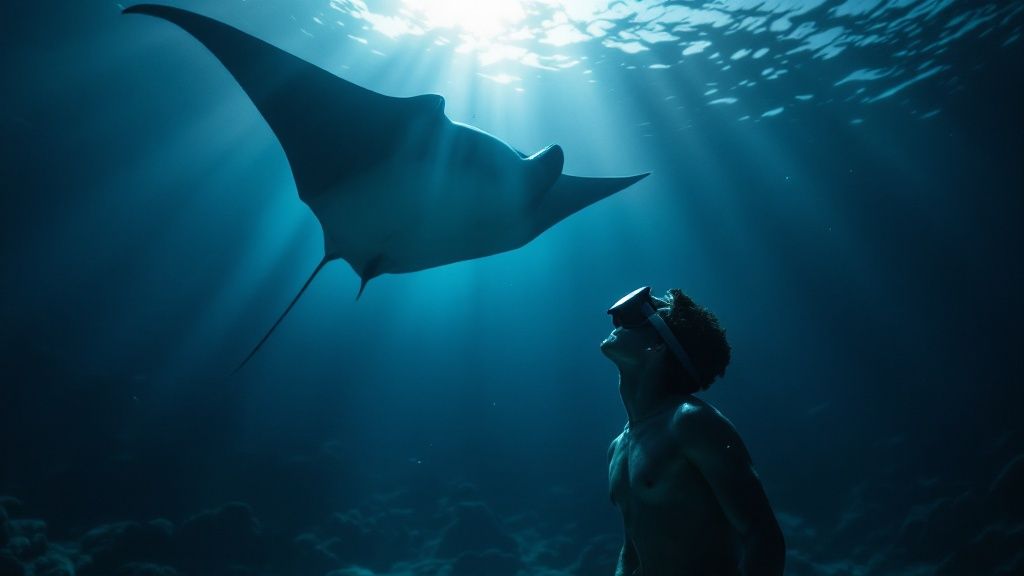
The Magic of Manta Ray Snorkel Kona: Why It's Unforgettable
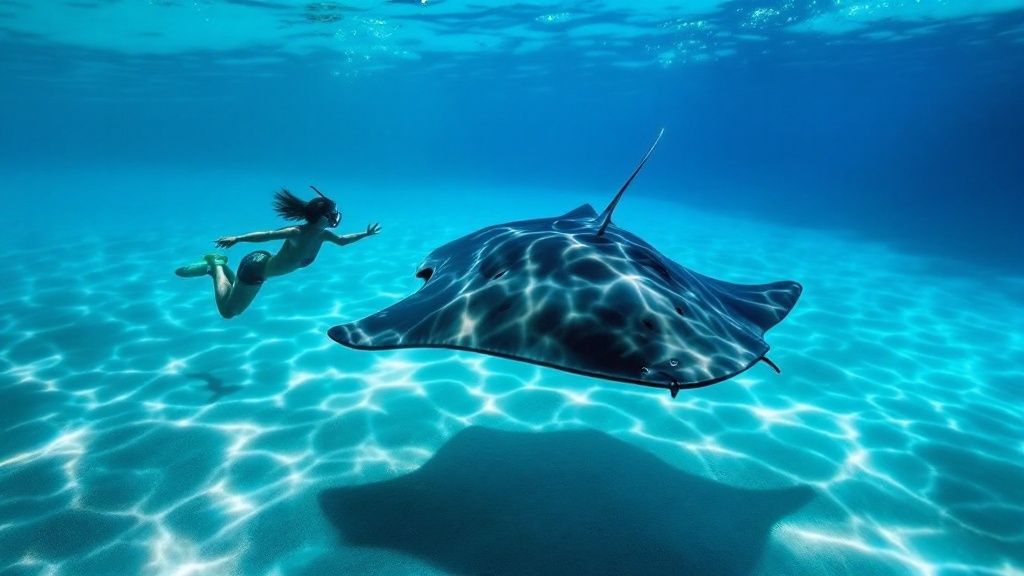
Imagine floating beneath the stars in the dark Pacific Ocean. Suddenly, huge, graceful shadows appear from the depths, their wingspans reaching up to 20 feet. This is the magic of a manta ray snorkel in Kona, Hawaii. These gentle giants glide below you, drawn to the plankton attracted by dive lights. It creates a beautiful, almost otherworldly underwater ballet.
This experience is more than just an activity; it's a powerful encounter with nature. Many visitors feel a deep connection with the ocean and its creatures after this experience.
This incredible sight isn't just good fortune. Kona's volcanic landscape and nutrient-rich water create the perfect feeding grounds for manta rays. The sloping seabed generates upwelling currents that bring plankton to the surface, a true feast for these filter feeders. The calm, protected bays are ideal for nighttime snorkeling.
Kona offers a consistently high chance of seeing these majestic creatures, making it a popular destination. In fact, manta ray snorkeling tours in Kona attract approximately 80,000 participants every year. With an encounter success rate of 80-90%, it's one of the world's most reliable wildlife viewing experiences. This is thanks to the unique underwater volcanic terrain and plankton-rich currents. Learn more about Kona manta ray statistics here: https://konasnorkeltrips.com/blog/manta-ray-snorkel-kona/
Why Choose Kona for Your Manta Ray Snorkel?
Several factors contribute to Kona's reputation as the premier location for manta ray snorkeling:
-
Consistent Sightings: The high success rate means you're very likely to see these amazing animals.
-
Accessibility: Several tour operators cater to all skill levels, including Kona Honu Divers, Manta Ray Night Snorkel Hawaii, Kona Snorkel Trips, and Captain Cook Snorkeling Tours.
-
Unique Experience: The nighttime setting, illuminated water, and the graceful manta rays create a truly memorable event.
-
Year-Round Viewing: Manta rays are present in Kona all year, giving you flexibility when planning your trip.
A manta ray snorkel in Kona is truly special. The combination of predictable encounters, stunning surroundings, and the sheer size of these gentle giants creates a bucket-list experience you won't forget. With some planning, this incredible adventure can be yours.
Prime Spots: Where to Find Mantas Along Kona's Coast
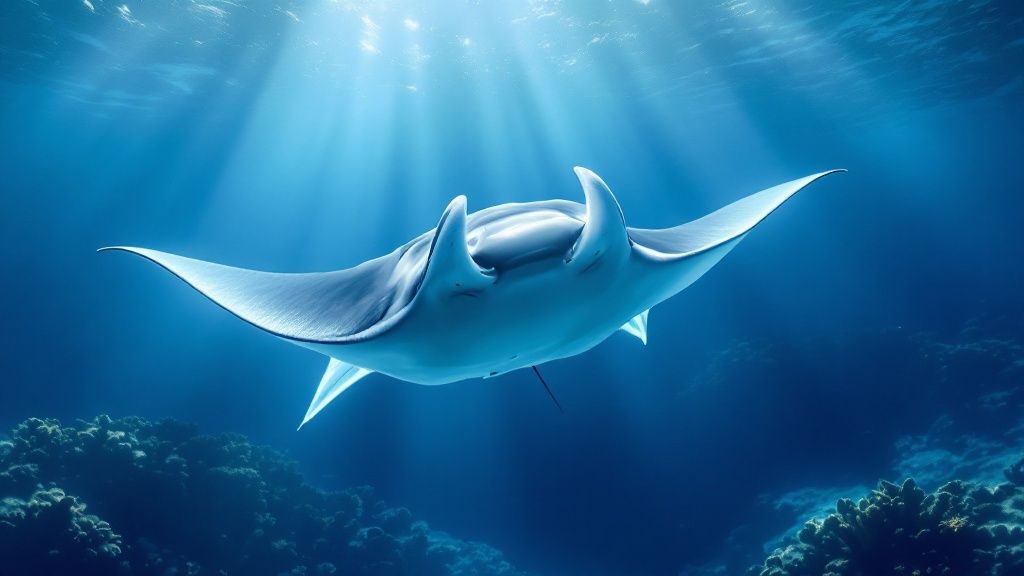
The Kona coast, formed by volcanic activity, offers a unique haven for manta rays. These gentle giants are drawn to the area's rich waters, making Kona a snorkeling paradise. Two spots, in particular, reign supreme: Manta Village in Keauhou Bay and Manta Heaven at Garden Eel Cove. Each location presents a unique perspective on these incredible creatures.
Manta Village: Keauhou Bay
Keauhou Bay, home to Manta Village, offers calm, shallow waters perfect for new snorkelers. The sandy bottom and gradual slope create a comfortable environment for observing mantas as they glide through the water, feeding on plankton. It's an ideal spot for a relaxed and enjoyable snorkeling experience.
Manta Heaven: Garden Eel Cove
Just north of Kailua-Kona, Garden Eel Cove, also known as Manta Heaven, provides a different encounter. This site, located in the open ocean, generally boasts larger manta ray populations. While the deeper water and occasional currents can present a slightly more challenging snorkel, the chance to witness numerous mantas feeding in their natural habitat is truly remarkable.
To enhance your experience, consider a guided tour like the Manta Ray Night Snorkel Big Island Adventure. Both Manta Village and Manta Heaven benefit from the nutrient-rich waters and unique underwater topography that attracts plankton, the manta rays' primary food source. However, weather conditions affect each location differently.
Keauhou Bay is generally more sheltered from strong winds. Garden Eel Cove, on the other hand, can be affected by rough seas, impacting visibility and the overall snorkeling experience.
Local research and tour operators provide valuable data about manta ray sightings. Operators like Jack's Diving Locker report 85-90% sighting success rates on night snorkel trips off Kona, though sightings are never guaranteed as mantas are wild animals. Garden Eel Cove is a favored location due to its proximity to departure points, higher manta ray concentration, and protection from rough seas, while Keauhou Bay is preferred for its shallower depth and gentle slopes. Journey times also vary, with Keauhou Bay often being a shorter boat trip. You might also be interested in How to master…
To help you choose the best location for your manta ray adventure, we've compiled a comparison of the two prime spots:
Kona's Top Manta Ray Snorkel Locations Compared
A detailed comparison of the two primary manta ray snorkeling sites in Kona, highlighting differences in accessibility, conditions, and manta ray activity.
| Feature | Manta Village (Keauhou Bay) | Manta Heaven (Garden Eel Cove) |
|---|---|---|
| Water Depth | Shallower | Deeper |
| Currents | Generally Calm | Can be present |
| Experience Level | Beginner-friendly | More experienced snorkelers |
| Manta Ray Population | Smaller groups | Larger groups |
| Accessibility | Short boat ride | Short to medium boat ride |
| Conditions | More sheltered from wind | More susceptible to rough seas |
As you can see, both locations offer unique advantages. Keauhou Bay provides calmer, shallower waters ideal for beginners, while Garden Eel Cove offers the potential for witnessing larger manta ray populations in a more open-ocean setting. Choosing the right spot depends on your experience level and desired adventure.
Timing Your Encounter: When Mantas Are Most Active
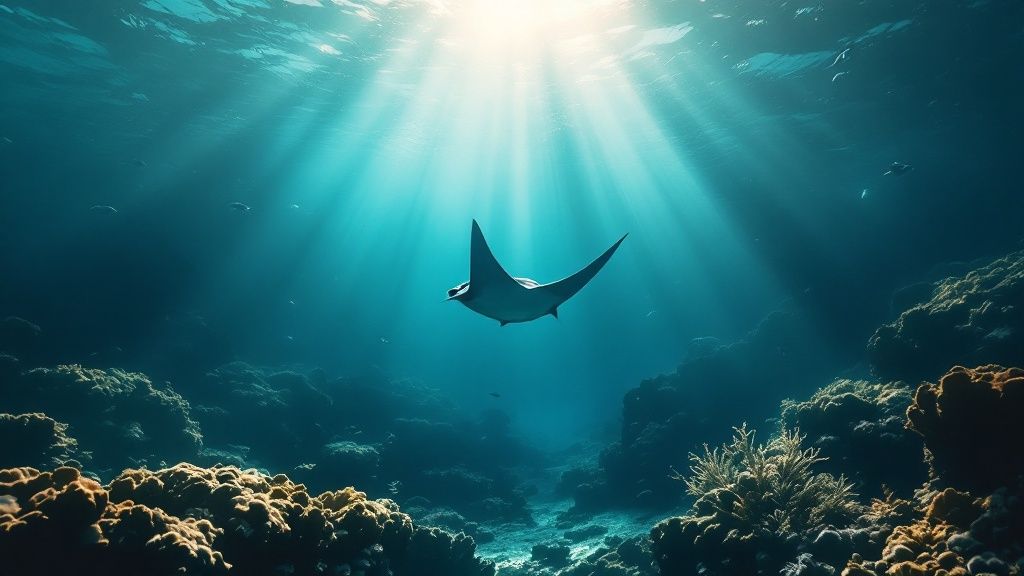
Manta rays are a year-round resident of Kona's waters. However, knowing when they're most active can greatly improve your snorkeling experience. Their activity largely revolves around their main food source: plankton. Specific times and conditions create more active and engaging manta ray encounters.
Moon Phases and Plankton: The Manta Buffet
Plankton, microscopic organisms, are the foundation of the manta ray diet. These tiny creatures are affected by the lunar cycle, rising closer to the surface during a new moon. This creates a feeding frenzy for manta rays. It attracts them to feeding areas in greater numbers, leading to more dynamic snorkel experiences.
Water clarity also tends to be better during a new moon, offering enhanced visibility. A full moon, conversely, can scatter light in the water, sometimes reducing visibility.
Seasonal Variations: Calm Seas and Peak Activity
Kona's weather patterns change throughout the year, impacting ocean conditions and manta ray activity. Summer typically brings calmer seas, creating smoother boat rides and easier snorkeling. This is especially helpful for those susceptible to seasickness.
Manta rays remain active throughout the year. This ensures a fantastic manta ray snorkel Kona experience, regardless of the season.
Kona Coast Manta Ray Research (2009-2014)
Between 2009 and 2014, researchers tracked manta ray sightings along the Kona Coast, focusing on "Manta Village" and "Manta Heaven." They identified individual mantas, assessed their health, and tracked their movements.
This research revealed consistent activity patterns, providing valuable insights into peak periods. In 2013, for instance, researchers regularly observed around 50 individual manta rays. More detailed statistics can be found at Manta Ray Advocates.
Shoulder Seasons: The Sweet Spot?
The shoulder seasons (spring and fall) present a unique advantage. These periods often have fewer crowds while maintaining excellent viewing conditions. This translates to less competition for the best viewing spots and a more personal encounter with the manta rays.
Sunset Timing and Night Snorkeling
As sunset times change with the seasons, so do night snorkel schedules. Tour operators like Kona Snorkel Trips, Kona Honu Divers, Manta Ray Night Snorkel Hawaii, and Captain Cook Snorkeling Tours adjust their departure times. This maximizes your time with the mantas after dark.
Planning your manta ray snorkel Kona adventure goes beyond simply selecting a reputable operator. By considering these factors, you can improve your chances of a truly unforgettable encounter with these gentle giants.
Preparing for Your Manta Ray Adventure: Beyond the Basics
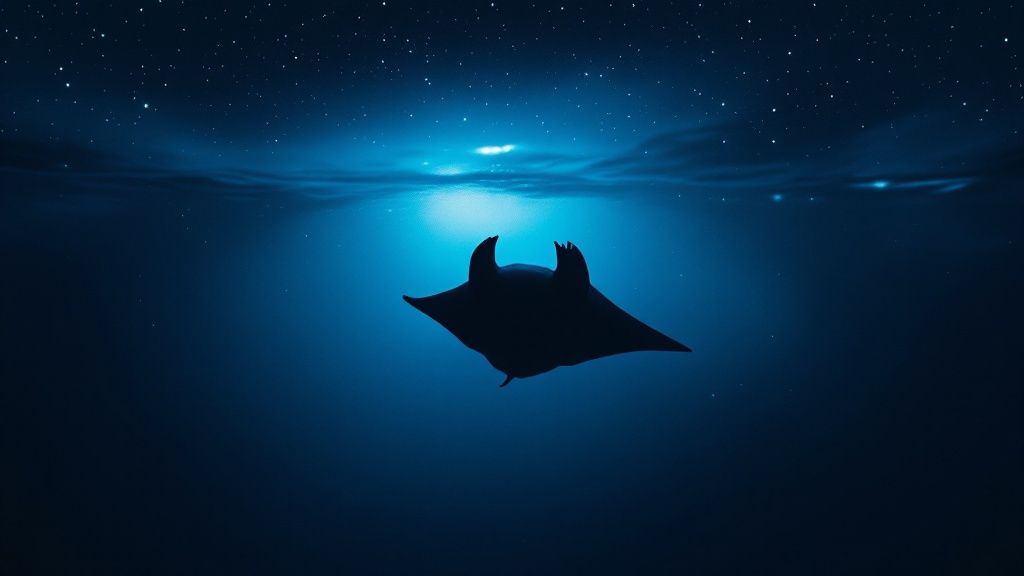
So you're ready for a manta ray snorkel Kona experience. But how can you make the most of this incredible adventure? This section goes beyond the typical packing lists and dives into the expert advice seasoned guides offer newcomers.
Managing Pre-Swim Jitters
Night snorkeling can be a new experience, and many first-timers feel a little anxious about entering the water in the dark. This is perfectly normal! Reputable manta ray snorkel tour operators prioritize your safety and offer detailed briefings before you even get close to the water. These briefings cover everything from basic snorkeling techniques to what you can expect in the dark, helping you feel comfortable and prepared.
Staying Warm and Comfortable
Even in Kona, the ocean can get cool at night. Wearing a wetsuit is crucial for staying warm – most tour operators provide these. Think of it as a cozy underwater blanket. Many operators also offer rash guards for extra warmth and protection.
Preventing Mask Fog
A foggy mask can obscure your view of the manta rays. Before you enter the water, apply anti-fog solution to your mask's interior. This simple step will keep your vision crystal clear, so you can fully appreciate the grace and beauty of these gentle giants.
Positioning for the Best Encounters
Manta rays are drawn to the lights that attract plankton. Position yourself near the designated viewing area and stay relaxed – this will encourage the mantas to approach you. Avoid making sudden movements, as this could frighten them away. Patience is key! Manta rays are naturally curious and will often swim very close to snorkelers who remain still and respect their space.
Underwater Camera Tips for Low-Light Conditions
Want to capture the magic of your manta ray encounter? Consider bringing a compact or action camera with manual settings. Utilize a fast shutter speed to freeze the mantas’ movements, and a wide aperture to maximize light intake. A high ISO setting can help in low light, but it might introduce some graininess to your images. For a deeper dive into underwater photography, check out our guide: How to master…
Motion Sickness Prevention
If you are susceptible to motion sickness, taking precautions before your tour is a good idea. Consider taking ginger supplements or over-the-counter motion sickness medication. The boat ride to and from the snorkel site can sometimes be choppy, depending on sea conditions. Preparing beforehand will allow you to fully enjoy the experience without discomfort.
By following these tips, you'll be well-prepared and comfortable during your manta ray snorkel Kona adventure. From pre-swim jitters to capturing stunning underwater photos, these insights will help you create an unforgettable experience.
Selecting Your Perfect Manta Ray Snorkel Tour Experience
Picking the right manta ray snorkel tour can make or break your trip. Kona offers an incredible variety of tour operators and options, ensuring you can find the perfect fit for your needs and desires.
Boat Types and Comfort Levels
Boat type plays a major role in your overall comfort. Smaller rafts offer a more intimate experience, perfect for those seeking a close-to-nature adventure. They can also navigate into smaller, secluded coves. Larger vessels, on the other hand, provide added stability and amenities like restrooms, ideal for families with young children or those who prefer a more comfortable ride.
Budget-Friendly vs. Premium Tours
Manta ray snorkel tours in Kona come at a range of prices. Budget-friendly options concentrate on getting you to the manta ray viewing site efficiently. Premium experiences offer additional benefits, such as smaller groups, guided tours by marine biologists, and high-quality snorkeling equipment. These extras can significantly enhance your manta ray encounter.
Specialized Tour Features
Many tours cater to specific needs. Families can choose tours that prioritize safety and easy water access. Photography buffs will appreciate tours with dedicated camera platforms and expert photography tips. Some operators even specialize in accommodating individuals with mobility limitations, offering extra help getting in and out of the water.
Eco-Conscious Snorkeling
Protecting the manta rays and their fragile ecosystem is crucial. Look for tour operators committed to sustainable tourism practices. These operators may adhere to strict wildlife interaction guidelines, use eco-friendly boats, or donate to marine conservation efforts. Choosing a responsible operator helps preserve this incredible experience for generations to come.
Group Size Matters
Consider group size carefully. Smaller groups allow for more personal space and interaction time with the manta rays. Larger groups can be more budget-friendly, but may lead to less individual viewing time. Choosing the right group size can drastically affect your overall experience.
Kona's Leading Manta Ray Snorkel Operators Compared
To help you make an informed decision, we've compiled a comparison of Kona's leading manta ray snorkel tour operators. This table highlights their key features, pricing, and what makes each one unique.
| Tour Operator | Group Size | Departure Location | Tour Duration | Special Features | Price Range |
|---|---|---|---|---|---|
| Kona Honu Divers | Small | Honokohau Harbor | ~2 hours | Personalized experiences, small groups | $$$ |
| Manta Ray Night Snorkel Hawaii | Varies | Keauhou Bay | ~2 hours | Specialized night snorkeling | $$ |
| Kona Snorkel Trips | Varies | Honokohau Harbor | ~2-3 hours | Diverse snorkel trips, including Captain Cook | $$ |
| Captain Cook Snorkeling Tours | Varies | Keauhou Bay | ~3-4 hours | Educational focus, marine life encounters | $$ |
As you can see, each tour operator offers a slightly different experience. Considering your budget and desired features will help you find the best fit.
By taking the time to research your options and consider your priorities, you're sure to find the perfect manta ray snorkel tour in Kona, creating a truly unforgettable experience.
Manta Science: Understanding the Giants of Kona
A manta ray snorkel Kona adventure offers an unforgettable experience. More than a simple thrill, it provides a unique opportunity to learn about these gentle giants. Their world extends far beyond what we see on the surface, full of intriguing details waiting to be discovered. It's a story of science and conservation, essential for understanding and protecting these magnificent creatures.
Identifying Individual Mantas: Nature's Fingerprints
Did you know each manta ray has its own unique spot pattern? These markings, located on their underside, are like fingerprints. Researchers use them to identify and track individual mantas, just like detectives in a mystery novel!
This identification process helps scientists learn a lot about manta ray lives. They can monitor populations, track migration patterns, and even gather information about their lifespan and social interactions.
Even better, your vacation photos can contribute to this research. Sharing your manta ray pictures with conservation organizations helps scientists expand their databases and learn even more about these amazing animals.
Feeding Behaviors and Nighttime Snorkeling
Manta rays are filter feeders, meaning they consume large quantities of tiny plankton. They're attracted to the lights used by snorkel boats because these lights draw plankton to the surface.
This feeding behavior makes nighttime snorkeling with manta rays a truly unique experience. As they gracefully move through the illuminated water, the mantas create a breathtaking spectacle. It's a chance to witness their intelligence as they navigate the currents, collecting their microscopic meals.
Lifespan, Social Behaviors, and Threats
These gentle giants can live surprisingly long lives, potentially up to 50 years. They demonstrate complex social behaviors, often forming groups to feed and interact with each other.
Unfortunately, Hawaiian manta rays face several threats. Entanglement in fishing gear, habitat degradation, and ocean pollution are all major concerns for their continued survival.
Sustainable Tourism and Conservation Efforts
Sustainable tourism is crucial for protecting manta rays in Kona. Responsible tour operators use revenue from tours to fund vital research and conservation programs. Many operators actively collaborate with organizations committed to preserving these incredible animals. By choosing a sustainable tour, you directly support the long-term well-being of the manta ray population and its ocean home. Consider researching options on how to choose sustainable tours, for example: How to master…
Supporting Manta Ray Conservation
Numerous organizations dedicate their efforts to safeguarding manta rays. Supporting these groups is vital for ensuring the future of these gentle giants. Their work includes public education, scientific research, advocating for protective policies, and rescuing entangled or injured mantas.
You can actively contribute to manta ray conservation by choosing to snorkel with responsible operators like Kona Snorkel Trips, Kona Honu Divers, Manta Ray Night Snorkel Hawaii, or Captain Cook Snorkeling Tours. This allows you to witness these creatures firsthand while supporting their protection. Your Kona manta ray experience transforms into more than just a memory—it becomes a valuable contribution to their future.
Maximizing Your Manta Encounter: Pro Tips and Techniques
Want to transform your manta ray snorkel Kona adventure from memorable to truly unforgettable? This section compiles advice from experienced underwater photographers, seasoned guides, and marine biologists to help you make the most of your time with these gentle giants.
Respectful Positioning: Getting Close Without Intrusion
Proper positioning is crucial for an amazing manta ray experience. Understanding their behavior helps increase close encounter opportunities while respecting their space. Avoid chasing the mantas. Instead, settle in near the designated viewing area and let them approach you. Patience is often rewarded with incredible, up-close views.
Never touch the mantas. Their seemingly tough skin is covered in a delicate mucus layer that protects them from infection and disease. Human touch can disrupt this vital layer. Maintain a respectful distance for their well-being.
Understanding Manta Behavior: What Attracts (and Repels) Them
Manta rays are drawn to plankton, which congregates around dive lights. But certain human behaviors can inadvertently scare them away. Splashing, loud noises, and sudden movements can startle these graceful creatures, prompting them to leave the area.
Remaining calm and quiet is essential. Become a passive observer, blending in with the underwater environment. This approach improves your viewing experience and minimizes disturbance to the mantas.
Night Photography Tips: Capturing the Magic in Low Light
Even with simple underwater cameras, you can take stunning photos of these nighttime dancers. Key tips for night photography include using manual settings (if available) and practicing patience for the perfect shot. Increase the ISO to compensate for low light, but be mindful of potential graininess. A fast shutter speed will freeze the manta rays' motion, while a wide aperture, like f/2.8, will maximize light intake.
Start with a shutter speed of 1/250 of a second and your widest aperture. Then, adjust the ISO as needed according to the available light and your camera's performance at higher ISO levels.
Staying Calm During Close Encounters: Breathing and Mindfulness
A close encounter with a manta ray can be exhilarating. Remaining calm enhances the experience. Focus on your breathing. Slow, deep breaths help regulate excitement and prevent sudden movements that might frighten the mantas.
This mindful approach elevates the encounter beyond simple observation into a powerful connection with these gentle giants, fostering deep appreciation and lasting memories.
Learning from Repeat Visitors: Secrets of Memorable Encounters
Experienced manta ray snorkelers often stress the importance of patience and mindfulness. Many recount that their best encounters occurred while remaining still, allowing the mantas to approach out of curiosity, resulting in a profound emotional bond.
These firsthand accounts underscore the importance of respecting the mantas' space and admiring their natural behavior. By using these tips and techniques, you too can make the most of your Kona manta ray snorkel trip and create an extraordinary adventure.
Book your manta ray snorkel tour with Kona Snorkel Trips today and experience the magic for yourself!
